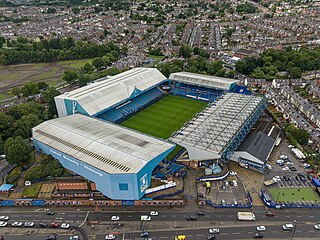
Hillsborough Stadium is a football stadium in Sheffield, England. It has been the home of Sheffield Wednesday since opening in 1899.

Notts County Football Club is a professional association football club based in Nottingham, England. The team compete in EFL League Two, the fourth level of the English football league system.

Filbert Street was a football stadium in Leicester, England, which served as the home of Leicester City F.C. from 1891 until 2002. Although officially titled the City Business Stadium in the early 1990s, it remained known almost exclusively by its address, like many English football stadiums.

West Bridgford is a town and the administrative centre of the Borough of Rushcliffe, in the county of Nottinghamshire, England. It lies south of Nottingham city centre, east of Wilford, north of Ruddington and west of Radcliffe-on-Trent. It is also southwest of Colwick and southeast of Beeston which are on the opposite bank of the River Trent. The town is part of the Nottingham Urban Area and had a population of 36,487 in a 2021-census.
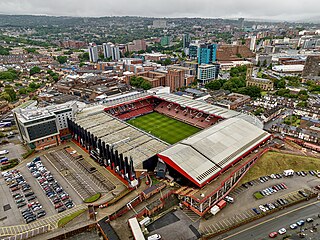
Bramall Lane is a football stadium in Sheffield, South Yorkshire, England, which is the home of Sheffield United.

Trent Bridge Cricket Ground is a cricket ground mostly used for Test, One-Day International and county cricket located in West Bridgford, Nottinghamshire, England, just across the River Trent from the city of Nottingham. Trent Bridge is also the headquarters of Nottinghamshire County Cricket Club. As well as international cricket and Nottinghamshire's home games, the ground has hosted the Finals Day of the Twenty20 Cup twice and will host the final of the One-Day Cup between 2020 and 2024.

Spion Kop is a colloquial name or term for a number of single-tier terraces and stands at sports stadiums, particularly in the United Kingdom. The steep nature resembles the Spion Kop, a hill near Ladysmith, South Africa, which was the scene of the Battle of Spion Kop in January 1900 during the Second Boer War.

The City Ground is a football stadium in West Bridgford, Nottinghamshire, England, on the banks of the River Trent. It has been home to Nottingham Forest F.C. since 1898 and has a capacity of 30,455.
James Sirrel was a Scottish football player and manager; he gained his highest profile in the latter role.

Bloomfield Road is a football stadium in Blackpool, Lancashire, England, which has been the home of Blackpool Football Club since 1901. It is the third stadium in the club's existence, the previous two being Raikes Hall Gardens and the Athletic Grounds.

The Racecourse Ground, known for sponsorship reasons as the STōK Cae Ras, is a football stadium in Wrexham, Wales. It is the home of Wrexham A.F.C.
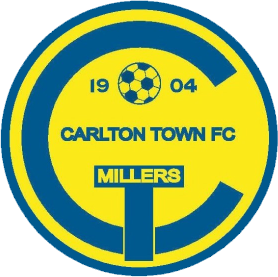
Carlton Town Football Club is a semi-professional football club based in Gedling, Nottinghamshire, England. Founded in 1904 as Sneinton Football Club, its early years were marked by considerable local success, leading to the club being described by the Manchester Courier in 1909 as "the leading amateur football club in Nottingham". Its reputation declined for several decades afterwards, with the team participating in obscure county divisions until the 1995–96 season saw the club join the nationwide league system. Carlton currently competes in the Northern Premier League Division One East at the eighth tier of the English football pyramid.
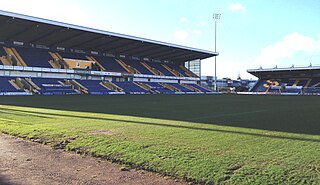
Field Mill, currently known as One Call Stadium for sponsorship reasons, is a football ground in Mansfield, Nottinghamshire, England, and the home of Mansfield Town Football Club.
Notts County Ladies Football Club was a women's football club based in Nottingham, England. They played their home games at Meadow Lane.
Ronald Fenton was an English football player, coach and manager. He played as an inside forward and made nearly 200 appearances in the Football League.
Harry Butler Daft was an English footballer who played for Notts County, with whom he won the FA Cup in 1894, as well as making five appearances as a left winger for the national side. He was also an accomplished first-class cricketer, playing 200 matches for Nottinghamshire between 1885 and 1899.
Frederick William Banks was an English professional footballer who made 72 appearances in the Football League playing for Birmingham and Nottingham Forest. He played as an outside forward.
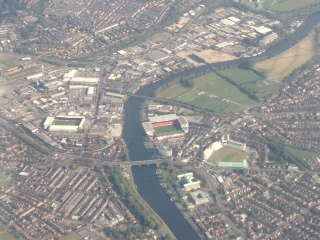
Nottingham is home to several high-profile sports clubs. These include two notable Football League clubs in the shape of Nottingham Forest which, along with Liverpool, is one of only two clubs in England to have won consecutive European Cups and Notts County which is the oldest professional football club in the world. Nottinghamshire County Cricket Club is a top level county cricket club, whilst both the National Ice Centre and the National Watersports Centre are also located in the city.
The 2015–16 season was Notts County's 153rd season in their history and their first season back in League Two since being relegated from League One the previous season. Along with League Two, the club will also compete in the FA Cup, League Cup and League Trophy. The season covers the period from 1 July 2015 to 30 June 2016.
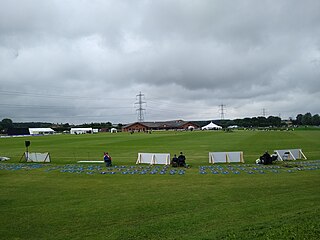
The John Fretwell Sporting Complex is a cricket ground located at Sookholme near Market Warsop in Warsop parish, Nottinghamshire, England. The ground, which also has facilities for football and bowls, is the home of Welbeck Cricket Club and has been used by Nottinghamshire County Cricket Club for some List A fixtures since 2015.




















